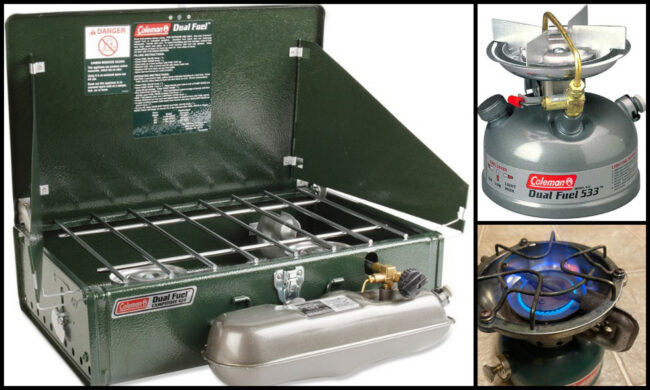Stoves
When you’re out in the wilderness, nothing else makes the experience more enjoyable than a good meal or a hot cup of whatever.
In many parts of the country the building of fires is prohibited due to the wildfire hazards. What that means is that if you want a hot meal or beverage, you’ll have to bring a stove with you. There are several types, each with advantages and disadvantages.
If you’re serious about carrying the minimum weight possible, you’ll want to look at chemical stoves. These use a variety of flammable materials from denatured alcohol to solid fuel tablets. The total weight of the stove can range from less than an ounce to a very few ounces. Some folks make stoves out of soda cans, others tin cans. If you don’t want to build your own, look in your local sporting goods store, or on the internet for manufactured stoves. These tend to be very low cost, low weight and fairly efficient. The only time these don’t’ work well is at high altitude and/or in windy conditions. The wind issue can be resolved with a lightweight wind screen.
One category of stove that has really gotten popular are tiny wood-burning models. These can be super lightweight as well, weighing in a just a few ounces, based on what they’re made of. The two most popular are stainless steel and titanium. They vary considerably in size and some can even by hybrid stoves that allow for the use of an alcohol burner in the stove when wood is not available.
If you’re going to do winter or high-elevation camping, you’ll want to move up the next category of stoves. These ultra-light stoves offer tremendous heat at all altitudes and in all weather. They run on iso-butane and basically are “flame throwers” putting out tremendous heat. They can be a bit wind-sensitive, but like the alcohol stoves can be made more efficient with a windscreen. My only real complaint with these are that they’re very noisy. The biggest advantage to these is that they cook faster than all other stoves.
Back when I was in Boy Scouts I used something called a Sterno Stove. It used pre-packaged denatured alcohol gel and was fairly lightweight. These stoves have been around for decades and are basically “bullet proof” on how they work. The earliest models that I’ve seen were prone to wind issues but the later models have corrected that with good shielding as part of the design. They come in single and double burner models. The fuel comes in various sizes for weight. I’ve NEVER had a problem using a Sterno Stove at any time. I have several and once in a while still use them, just for nostalgia’s sake.
In the liquid fuel category, you can go with stoves that use only “white” gas (Coleman type), or multi-fuel stoves which can burn everything from white gas to kerosene to plain gasoline to aviation fuel. Personally, I like the MSR Whisperlite International 600 with shaker-jet. It’s a regular flame-thrower, and can run on almost anything that’ll burn. To date it’s been very dependable and works well under all weather conditions. With a multi-fuel stove you can find fuel almost anywhere in the world. The negative to any liquid fuel stove is that they can be messy to work with, usually requiring “priming” before use, making them sooty.
If you’re car camping, it’s hard to do any better than the old standard Coleman multi-burner stoves. They come in liquid and propane models and have been a mainstay of camping for decades. Their dependability is unquestionable. I’m using a stove which is probably almost as old I am. To date, I haven’t even had to replace the generator. The only downside to these stoves is that the liquid models do tend to “flare up” when cold, but otherwise they’re excellent. The best thing about the propane models is that they come in a variety of sizes and configurations, from single-burner to full Camp Kitchen deluxe models. Many have griddles that you can add to the top for pancakes and frying eggs and such. Some even have places to add skewers for kebobs.
Last modified on: January 3rd 2023.






